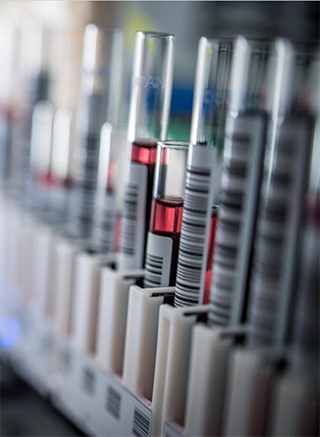By Florence Collins
Barcodes play a central role in minimizing the risk of error in lab automation by providing secure tracking of components throughout the workflow. Barcode-guided lab automation can be simple and cost-effective, with significant paybacks thanks to productivity increases.

1D barcode labeling is optimal for test tubes
From lab bench to LIS
Barcodes can be used to track everything from individual tubes and samples to carousels, slides, microplate readers, washers, and between different locations and points of storage. Barcodes also simplify secure linkage of sample to result when using analyzers coupled to laboratory information systems (LIS) and hospital information systems (HIS). The truly successful labs have found ways to smoothly integrate barcode scanning and printing productively and profitably. The key is to use the right approach, including the best barcode symbology, as we will see here.
Barcoding brings efficient control to lab automation
Whatever you do to automate your lab, ensuring correct handling of samples and other components of the workflow must always be a key consideration including, for example, ensuring the reliability of barcode reading. There should be no need for a trade-off between speed and accuracy—you get it fast AND you get it right. Implementing barcodes into your workflow can be smooth and avoid bottlenecks caused by added time required for scanning, enabling fast and accurate data collection with a minimum of effort.
Code 128 preferred for the side of tubes
There is a wide range of barcodes, both linear and two-dimensional codes. Two-dimensional barcodes are ideal for internal sample storage and tracking where the tube is small and there are a large number of stored samples. These barcodes are commonly used on the bottom of microtubes supplied in a standard format 96·well rack. Two-dimensional barcodes can have up to ten times higher information density than linear codes and a lot of redundancy to cope with problems such as coverage by ice, but are not human-readable. However, linear barcodes are generally preferable when labeling the side of tubes since a ‘slice’ of readable bars and spaces anywhere up or down the barcode is all that is needed. Linear barcodes also avoid the risk of misreading due to distortion caused by tube curvature.
Of the linear barcodes, Code 128 has become the recommended standard since 2003 and has superseded other standards such as Codabar, Code 39, and Interleaved 2 of 5. Code 128 is the most compact of the linear barcode standards and can be used for alphanumeric or numeric-only barcodes. It can encode all 128 characters of ASCII and extended versions offer even more flexibility. Only Code 128 brings the highest level of security in linear codes and is currently the most common format used in life science and clinical laboratories.
Pre-barcoding or labels?
The decision to use linear Code 128 seems to be a given, but how should the barcodes be included on tubes? Pre-barcoded labware may seem expensive and inflexible, but they are more robust than labels. Some labware suppliers offer the option to choose from available non-custom options or call for customized options in a wide range of choices of code type, length and format. Tubes, for example, can have specific barcodes etched or printed onto them by companies such as Tubewriter (www.tubewriter.com).
Labels are available with a range of chemical and physical compatibilities to cope with extreme conditions, including liquid nitrogen (-196 °C) and a wide range of solvents.
How to automate barcode labeling in your lab
Traditional barcode labeling involved manual application of barcodes to tubes, vials and plates but this process is tedious and prone to error. In clinical labs, for example, samples may need to be read by many scanners, with increasing risks of error depending on labeling quality. Legacy systems may fail to read correctly if the barcode is not straight, while modern readers can handle barcodes in any orientation, including slanted barcodes.
A lot of barcode labeling systems are bench top size and can be used stand-alone or integrated into a sample preparation instrument. Whatever the solution, the lab has full control over the labeling process.
Development has gone so far that labeling systems can cope with tubes in hoppers that the system picks out, orientates, labels and then places in racks. These systems can handle over 400 tubes or vials per hour.
Barcoding for enhanced traceability and productivity
Summing up, barcoding is a cost-effective way to greatly improve traceability and productivity in laboratory workflows. An efficient barcoding system will involve Code 128 linear barcodes backed up with scanners that offer high scanning confidence, combined with speed and rapid feedback to ensure a smooth workflow. Following up on this article, we will be discussing the challenges and solutions in implementing barcodes with personnel at a lab and a leading manufacturer of barcoding solutions.
Sign up to the blog to receive updates!
About the author

Florence Collins
Florence Collins is a product manager at Tecan Switzerland. She holds a master's degree in Agronomy. She joined Tecan Systems in 2000 as key account manager in California and moved to Tecan’s head office as product manager in 2006.











